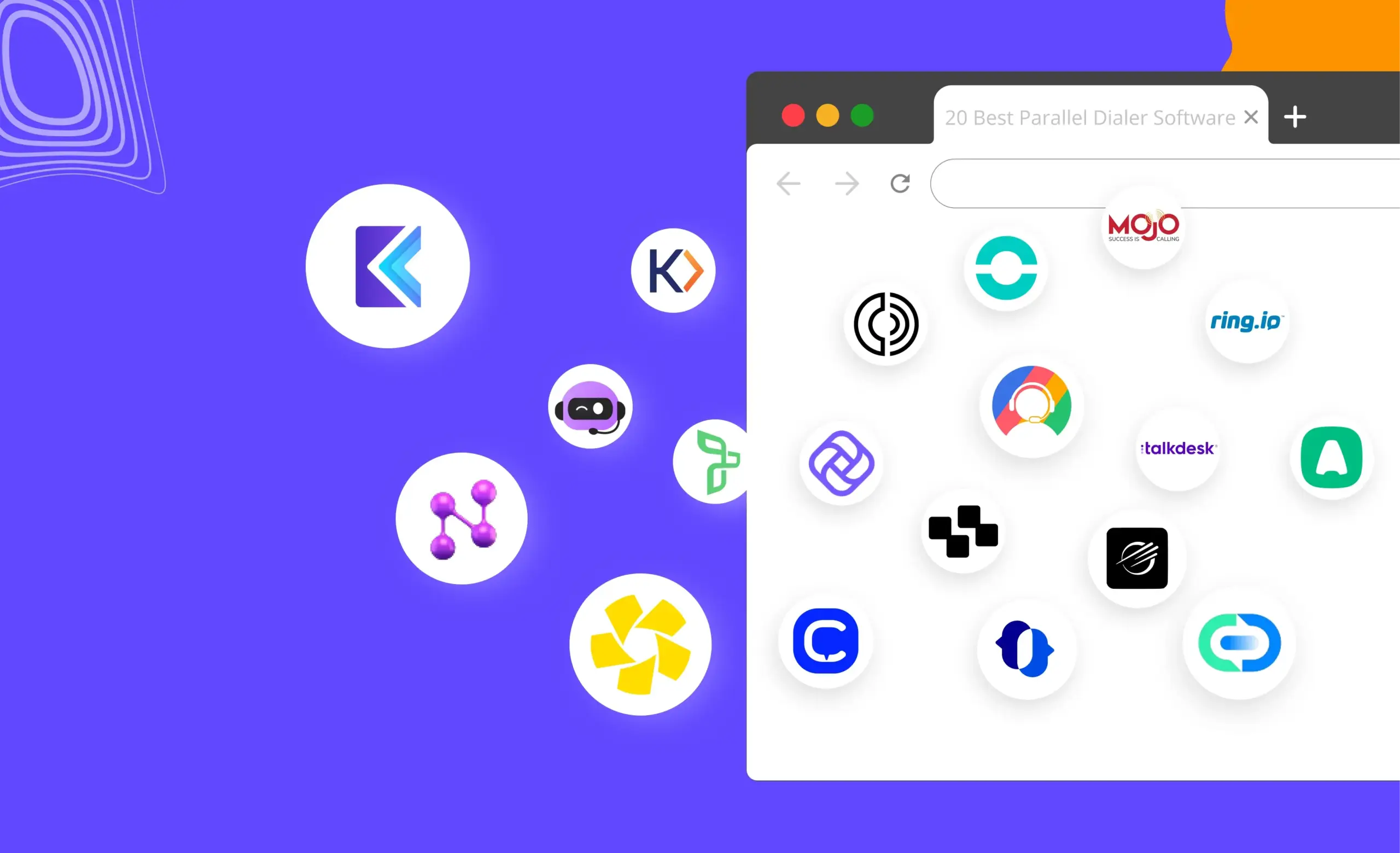After analyzing the performance of sales reps in 40,000 deals, here’s what McKinsey and Company found:
Top-performing reps relied on cold calls more than any other sales outreach channels, as they made 82% more cold calls than low performers.
This clearly shows cold calling is effective. But is it easy? Not quite.
After all, the process requires you to research your prospect, prepare a personalized pitch, dodge gatekeepers, and tackle sales objections. And all of these hinges on the prospect actually picking up your call, which doesn’t happen all that often.
So, to navigate this treacherous terrain of cold calling well, what you need is a handbook that guides you through each step of your cold call.
Fortunately, you don’t have to look far for this.
Here, we give you 20 actionable cold calling tips that you can integrate into your call scripts to not just meet but smash your sales quotas.
Does Cold Calling Still Work?
For those thinking cold calling is dead, sure, it is dead to the extent that its focus is not to make a sale anymore but to understand the needs of every prospect and highlight the value of your offering in relation to those needs.
Research finds that 57% of C-level and VP prospects, 51% of directors, and 47% of managers prefer being contacted by phone.
Couple this with the fact that the average cold calling conversion rate is 6.3%, and you’ll agree that cold calling today is a no brainer. It is a mile ahead of cold emails (which has a conversion rate of 0.5%) and is the preferred mode for your buyers.
So yes, cold calling still works. These cold calling statistics speak for themselves. There really isn’t a better way to know if your pitch is working in real time and add a human touch to your sales outreach than cold calling.
20 Effective Tips for Cold Calling to Book More Meetings
Pre-Call Preparation Tips
Benjamin Franklin once said, “By failing to prepare, you are preparing to fail.” His words ring true even in the sales outreach space.
If you want to make high-impact cold calls, you need to plan your strategy and know your prospect well enough for the strategy to yield results. To help you with this, here are 6 tips to keep in mind before jumping on a cold call:
1. Prepare a Cold Calling Checklist
We get it, cold calling can be an overwhelming process to begin with. And so, the best thing to do is to create a cold calling checklist. Here’s what to include:
- Pre-call Checklist
- Prepare your prospect list
- Segment and review your list
- Do your pre-call prospect research
- Find the best time to call
- Review your cold calling script
- Get in the calling groove
- On-the-call Checklist
- Have a strong cold call opener
- Ask open-ended questions
- Craft your cold call pitch well
- Handle different objections
- Move them to the next step
- Post-call Checklist
- Update your cold call tracking sheet
- Plan your cold call follow-up
- Analyze your cold call

2. Research Your Prospect Well
Researching your prospect is key to having a fruitful cold call. But considering you might have 100 cold calls to make in a day, you need to economize your time well while knowing where to look for crucial details about your prospect. Otherwise, you'll fall into a research abyss where the concept of time doesn't exist.
Stay on track with these 3 tips:
- Allocate No More Than 5 Minutes
Nikita Solberg, a top-performing SDR, swears by this rule as it helps them find “all the relevant information without wasting time.”
Scan your sales engagement platform and study their company details such as market share, recent announcements, collaborations, etc. And as the buzzer sounds, dial the call!
- Focus Only On the Essential Details
Don’t fall down the rabbit hole and stick to what’s important. Sam Holeman, a seasoned SDR, subscribes to an interesting trick-
“As I'm going through my tasks, I hit ‘call’, and go to their website. I've become fast enough that I can get all the information I need by the time they pick it up.”
Further, he focuses on two key elements: the prospect’s current software and who the decision maker is. This helps him avoid getting too deep while ensuring a productive cold call.
- Leverage 10-K Reports of Public Companies
10-K reports are a treasure trove when it comes to understanding your prospect’s company. Alastair Chamberlin, an experienced SDR manager, leverages this crucial resource to gain the following information on the prospect’s company:
- The company’s goals
- Their priorities
- Their focus for the year ahead
3. Enrich Your Prospect List
Enriching your prospect list means adding additional information to the data to gain a comprehensive view of your prospect. This process helps you fill gaps in your data and make it up-to-date and more reliable.
Considering that your prospect list serves as the foundation of your prospect call, ignoring it is not an option. You risk jeopardizing your entire sales pitch if you have inaccurate data on your prospect.
It's best to leverage data enrichment tools for the job. These solutions help keep your data accurate, and updated by enriching your prospect lists periodically.
4. Practice Your Cold Calling Script
You might have a stellar cold calling script, but if you fail to deliver it well, it’s as good as useless. For this reason, be sure to practice the script adequately before getting on the call.
Your call script should ideally follow the following framework:
- Start with a strong opener
- State the reason you’re calling
- Ascertain how sales-ready the prospect is
- Decide the next steps based on their sales readiness
Once you’re satisfied that the cold calling script ticks the above boxes, practice the call with your sales team supervisor or colleague to understand how best to leverage it.
PRO TIP: While practicing your cold calling scripts, aim for a downward inflection in your tone of voice. Josh Braun, a sales expert, says a downward inflection in your voice helps make you sound confident and sure of yourself while increasing the chances of a prospect opening up to you and feeling comfortable in the conversation. Conversely, an upward inflection makes you sound unsure and even judgemental at times.
5. Warm up Your Prospect
No one likes to be caught unaware, least of all your prospects. And so, it's best to thaw the encounter a little with warm calling. By adding a few alternative touchpoints before cold calling, you can familiarize your prospect with your offering and make the call more productive.
Having already heard from you before, your prospect is naturally less defensive about the intrusion and more receptive to what you have to say.
You can reduce the chill of your cold call by leveraging the following touchpoints:
- Cold Emails: Your cold emails must include personalized and relevant information that provides value to your prospect.
- LinkedIn Message: Analyze your prospect’s posts to create meaningful LinkedIn messages.
- Direct Mail: Post is not old-fashioned when it comes to making a good impression on your high-value prospects. Consider sending packages and modest gifts to get the conversation started.
- Organizing Events: Inviting your prospects to webinars, conferences, and industry events is a great way to introduce your offering with authority before you pick up the phone.
6. Find a Good Time To Call
The time of your cold call has a bearing on its success as well. Here are some points to note when looking for the best time to cold call your prospect:
- Your prospect is usually less busy and more willing to take your call between 4 and 5 pm.
- The second-best time to call your prospect is between 11 am and 12 pm.
- Stick to working hours and avoid dialing your prospect before 8 am and after 6 pm.
- Prioritize Wednesdays and Thursdays to make your cold calls.
- Avoid Mondays and the second half of Fridays while cold calling.
Tips To Make a High-Impact Cold Call
Once you have the groundwork done and dusted, it's time to dial the prospect and put all your preparation to good use. Here are tips to help you during your cold call:
7. Have a Strong Cold Calling Opener
Cold call opening lines set the tone of your entire conversation. Make sure to put some solid thought into what your first impression should be like. Here is what works for top performing SDRs:
- Permission-based Openers
Ashley Dees, an SDR manager, relies on permission-based openers. She says that her prospects “take it more as a sign of respect, that you're making sure it's okay to continue your pitch when you call them out of the blue.”
Some of her permission-based openers include:
- “Do you have a minute to chat?”
- “Is it a good time to talk?”
- “Sounds like you're driving and I don't want to bother you. Is it okay if I call you back tomorrow afternoon?” (She uses this if she senses on the call that the prospect is driving at the moment.)
- Delivering With Confidence
Make sure you deliver your opener with confidence. “People will stay on the phone with someone who's very confident,” asserts Sam Holeman, a top-performing SDR.
Here are some cold calling opening lines that he uses:
- “We've worked with a lot of people who have used {competitor} in the past and just haven't been happy with their software or looking for something more modernized. I had this idea for you”
- “I was looking around your website, I think you might be interested in this feature that we have. When would you be available to talk more about this?”
8. Ask Open-Ended Questions
Open-ended questions elicit more than a simple ‘yes’ or ‘no’ from the prospect. They force them to think and give you more insight into their perspective. Opt for questions that force the prospect to focus on themselves while helping take the conversation forward.
These are some open-ended cold calling questions that Nikita Solberg, a quota-crushing SDR, asks prospects in cold calls:
- “What are some of the things that have been eating up your time lately?”
- “What are some of the unnecessary tasks you've had to do instead of some of the things you'd rather be working on?”
- “May I ask how you have been managing your [Pain Point]?”
9. Build Rapport With Active Listening
Active listening involves focusing on what your prospect is saying, understanding it, and responding to it. The aim is to understand the prospect more intimately. Inflections in their voice, the underlying message in their words, tone, etc., can help you find easy segues into topics that can improve the quality of the conversation.
For instance, if you find your prospect pausing before answering whether they’re happy with their current solution, you could leverage that to ask them more targeted questions on the topic. To help you polish your active listening in cold calls, here are some quick tips:
- Avoid interrupting and listen to understand your prospect.
- Paraphrase or restate what your prospect says to confirm you’ve understood it completely.
- Don’t rush to complete your cold calling script.
- Ask open-ended questions to gain more information from your prospect.
- Avoid distractions when trying to listen to your prospect.
10. Personalize Your Cold Call
71% of consumers expect personalization today, according to McKinsey. That means you need to know your prospect and deliver customized pitches that talk directly to them. Or else, you don’t stand a chance.
To help you win at these, here are 5 strategies to personalize cold calls:
- Leverage Hyper-personalized Openers
Mention professional and personal details such as their job responsibilities, accomplishments, location, etc.
- Leverage Company Information
Details regarding the industry, recent announcements, product launches, news, etc., should make it to your sales pitch.
- Mention a Referral
Doing this allows you to establish a sense of familiarity with the prospect while providing a common ground to help start the conversation.
- Mention the Prospect’s Tech Stack
Your prospect’s tech stack can give you valuable insight into their current needs. Also, you can tell them how your solution integrates with their existing tech stack.
- Leverage Intent Data
Intent data is data gathered from the prospect’s online activity that lets you know how ready they are to make a purchase. Use this to make your sales conversations more relevant.
11. Qualify Before Pitching
Asking a series of qualifying questions will help you understand where your prospect stands when it comes to buying a solution. And based on this, you can deliver a personalized and relevant pitch. By the end of the call, you should know 3 things:
- Are they problem-aware?
- Is solving the problem a priority?
- Do they have a tool to solve the problem?
Gaining answers to this will help you understand how sales ready the prospect is.
12. Craft an Elevator Pitch
Your prospect usually gives you the first 30 seconds. After this, if you’ve piqued their interest, you can go ahead. Otherwise, it’s a hard rejection.
To avoid the second scenario, you need to create a quick elevator pitch with the following 3 ingredients baked into it:
- Personalization: The pitch must talk directly to the prospect and not sound generic.
- Pain Point with Value Proposition: The pitch must raise a pain point familiar to the prospect while highlighting what makes your solution worth their time.
- Engagement Questions: It’s not a monologue but a conversation. Include questions like “Have you tried addressing this pain point previously?” or “Does {Solution} help you streamline problems effectively?” to engage the prospect and have them participate in the cold call as well.
13. Use Local Dialing
Local presence dialing means reaching out to prospects using their local code. Considering people are 4x more likely to answer a local number, this is a great way to get your foot in the door. Here are a couple more benefits of local presence dialing:
- Improves your Reachability
With a local presence dial, prospects have a reliable and dedicated person they can get back to, as opposed to a toll-free number or a number with an unknown region code.
- Makes International Calls Convenient
Leveraging local presence dialing means prospects can call you on a local number, which can come in handy if you're leaving sales voicemails requesting callbacks.
Leading cold calling tools like Klenty offer local presence dialing to help SDRs book more meetings with prospects across the globe.
14. Handle Objections With the Right Mindset
Handling cold call objections is an essential part of prospecting over the phone. While there are several objections your prospects might pose, you need to cultivate the right mindset to overcome them with skill.
Here's how some of the top-performing SDRs approach objection handling in cold calls:
- Aamir Sohail: “My way to overcome objections is to educate them. So if I have key facts ready with me, if I can provide every single statistic or a fact based on the case, I think it will help me sell the product better.”
- Alastair Chamberlin: “It’s really important to have good knowledge of your customers and where they've come from whether they've come from a competitor or not. Because when you're objection handling, that’s really powerful.”
- Nanditha Menon: “When they say no, don't feel bad and cut the call. Always try to understand why exactly they say that.”
15. Get Past the Gatekeeper
Gatekeepers are individuals who control the access to prospects. These most often include administrative staff and receptionists who are tasked with screening calls based on their relevance, urgency, and importance.
Since sales calls have a bad reputation, they’re hard-wired to say no to you. So it's vital you know how to dodge them effectively. Here’s how top SDRs get past a gatekeeper:
- Talk To Gatekeepers the Right Way
Ashley Dees believes being honest, vulnerable, and kind can help you get past a gatekeeper. She opts for explaining her need to connect with the prospect and asks the gatekeeper to suggest what to do next. She tries to appeal to the gatekeeper with responses like,
“I wouldn't ask you to do that because I don’t want you to get in trouble. But, my boss is asking me to reach out to somebody from this account. What do you think I should do?”
- Build Rapport with Gatekeepers
Alastair Chamberlin says building a rapport with gatekeepers means discussing his offering with them. Once they realized how well the solution addressed their pain points, they let him connect with the prospect.
If that doesn’t work, Joel Thomas, another top-performing SDR, requests the gatekeeper to inform the prospect about the email he sent. Here’s what he tells gatekeepers:
“I’m going to send them an email with this subject line to the relevant person, and it will help me a lot if you could drop a message saying that they’re getting this email.”
- Circumvent Gatekeepers Completely
Sometimes, you might need to avoid gatekeepers altogether to get a hold of the prospect directly. For this, try:
- Have Accurate Contact Information: Nanditha Menon, a BDR, says gatekeepers often can’t understand the value of the solution as a decision-maker would. So, she opts to find the prospect’s direct contact details to eliminate an encounter with a gatekeeper.
- Call at a Later Time: Asatta Leggett, another BDR, lets the gatekeeper know she’ll call back in a week while ensuring she gets back within the next 2 days so as to catch the prospect directly.
16. Deal with Cold Calling Rejections
Only 2 out of 100 cold calls you make could have a positive outcome. So, to soldier on and keep dialing, you need to handle rejections in cold calling the right way. Here's a 3-step formula you can use to deal with cold calling rejections:
- Take a Breather After a Bad Call
Ashley Dees recommends spending time with your pets or taking a walk during a 10-15 break to help clear your mind before moving on to the next call. Take some time and rejuvenate.
- Revisit the Rejection with a Clear Mind
Next, view these rejections as learning opportunities and examine where things went wrong. Did you call them at the wrong time? Do they have budgetary constraints?
Getting to the root of the rejection helps you understand how you can tackle a similar one in the future and what can be tweaked in your script to get better results next time.
- Leverage Soft Rejections Smoothly
If a prospect says “I don’t have time”, or “Just send me an email”, counter these with cold call follow-ups such as “All right, what’s a good time?” and “Sure, what would you like me to include in the email?”
Tips To Have a Strong Post-Call Routine
Your cold calling efforts don’t end once your call ends. In fact, this crucial leg of your cold calling routine decides whether the deal will eventually close.
Here are 4 important tips to polish your post-call routine:
17. Lay Out the Next Steps
Based on your cold call, you need to decide what the next steps should be. To do this, segment your prospects into 2 groups:
- Prospects With Low Buying Intent
Prospects who aren’t ready to make a purchase or ones who are aware of the problem, but don’t aim to solve it any time soon fall into this category. The next step here is to share the necessary resources and stay in contact so that they choose you when they’re ready to buy.
- Prospects With High Buying Intent
This segment includes prospects who are ready to make a purchase or who are aware of the problem and want to solve it as a priority. The next step here is to set up a meeting.
18. Update Your Tracking Sheet
Once your cold call is over, you need to note down the call details while they’re fresh in your mind. For this, maintain and update a cold calling tracking sheet. Doing this allows you to chronicle your progress and keep your entire team in the loop as well.
Here are some ways to get the maximum out of your tracking sheet:
- Maintain separate trackers for different cohorts of prospects (unaware, problem aware, solution aware, product aware, and most aware)
- Always update the sheet periodically
- Integrate a sales engagement tool to gain a comprehensive view on all your prospects and their sales journeys
- Maintain a miscellaneous column to note information that might not fit under any column but can be instrumental in future calls (For e.g.-check how their dog is doing in case they mentioned them during the call, or ask how their favorite baseball team is fairing, etc.)

19. Analyze Your Call Recording
Once your callblocks are over, go back and examine your call recordings. This will help you identify what works in your cold call approach and what doesn’t.
However, manually listening to recordings can be time-consuming. This is why you need a conversation intelligence tool. This convenient solution transcribes, summarizes, and generates reports on your calls, ready for you to leverage during your cold call training session.
Conversation intelligence software helps you identify:
- Which of your cold call openers work the best
- What part of your call script needs improvement (value proposition, objection handling, etc.)
- Common cold calling mistakes you could be making
- Whether you're monologuing a lot or maintaining the right talk-to-listen ratio.
20. Automate Your Cold Calling Process
Lastly, integrate a sales engagement platform like Klenty into your sales outreach. Klenty’s Sales Dialer helps you place calls with a single click, organizes your prospect data and call scripts, while logging all your call notes into your CRM.
Here are some of Klenty’s notable features:
- Parallel Dialer: Call as many as 5 prospects at the same time, reducing 3 hours of dialing to just 30 minutes!
- Local Dial: Build trust with prospects and improve the chances of them picking up by dialing from numbers in their area.
- AI Note Taking: Klenty’s Call Intelligence Bot helps streamline operations by recording calls, taking notes, and logging them into your CRM.
- Drop Voicemails: Follow-up with your prospects by sending a voicemail in one click!
- Seamless Integrations: Save time on data entry with direct integrations, ensuring all call activities, manual notes, and scheduled tasks are synced to your CRM system.
To experience Klenty in action, book a demo now!
FAQs:
How Do You Stand Out on A Cold Call?
What Do You Do in The First 20 Seconds of Cold Call?
What Are the Do's and Don'ts of Cold Calling?
Do’s
- Prepare for the call and research your prospect thoroughly
- Be confident during a call
- Find the right time to call
- Integrate a sales automation tool
Don’ts
- Ask yes/no questions
- Badger the prospect once they say no
- Keep talking and not listen to your prospect
- Forget to update your tracking sheet and record your calls





